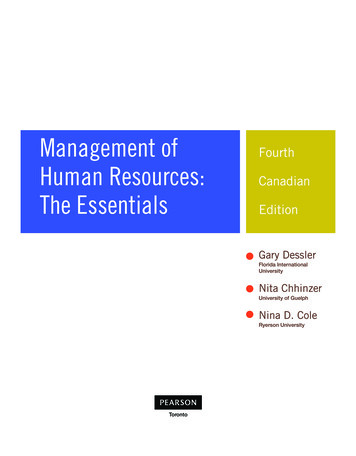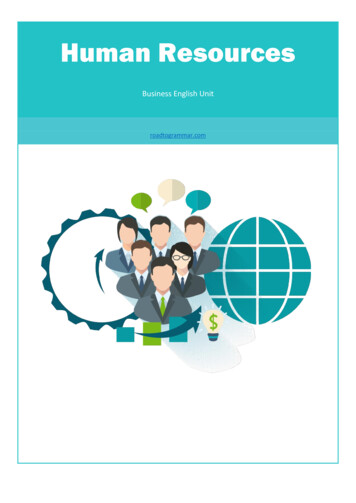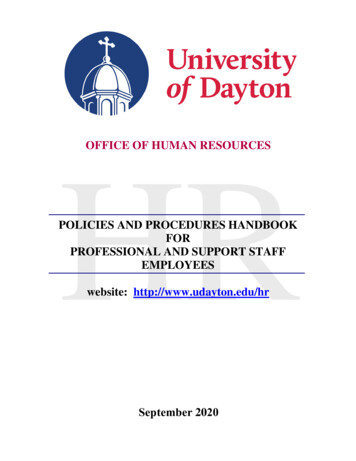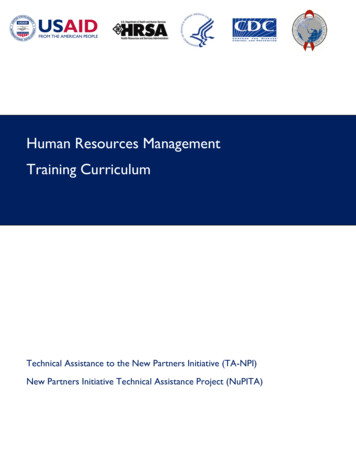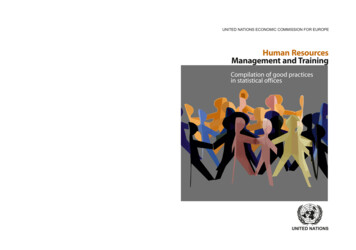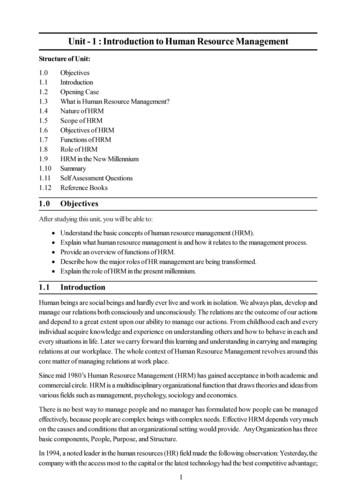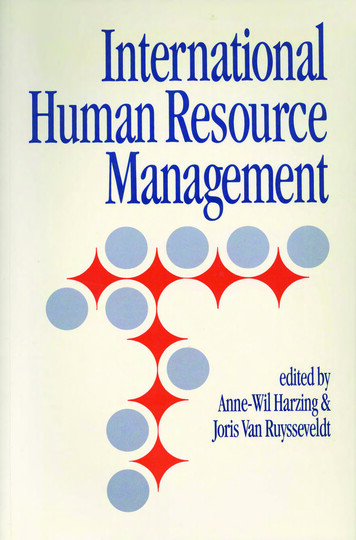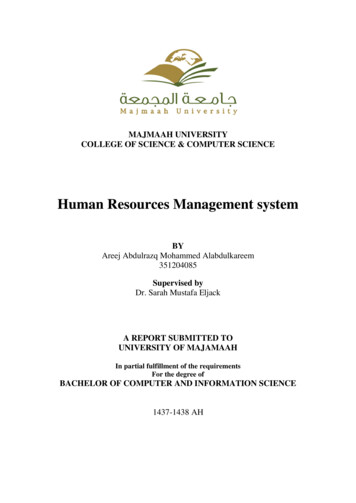
Transcription
MAJMAAH UNIVERSITYCOLLEGE OF SCIENCE & COMPUTER SCIENCEHuman Resources Management systemBYAreej Abdulrazq Mohammed Alabdulkareem351204085Supervised byDr. Sarah Mustafa EljackA REPORT SUBMITTED TOUNIVERSITY OF MAJAMAAHIn partial fulfillment of the requirementsFor the degree ofBACHELOR OF COMPUTER AND INFORMATION SCIENCE1437-1438 AH
In the Name of Allah, the Merciful, the Most Merciful" Allah will raise up in ranks those who believed among youand those who have been given knowledge. Allah is Aware ofwhat you do."The Reasoning -Al-Mujadala [58.12]II
DEDICATIONPersonally, I'd like to thank all those who have helpedwith their advice and efforts I'd like also to thank all Majmaah University staff andthe Computer Science staff, especially our supervisor,Dr. Sarah Mustafa Eljack for his valuable advices andthe work done in guiding us and guide us during thepreparation of this work.For our leader and our teacher . Muhammad IbnAbdullah (PBUH).For each person lit our paths of our knowledge.For all those who have helped with their advice andefforts.The esteemed professors in the College of Science andComputer science.For all the friends and everyone.I offer my research.III
ACKNOWLEDGMENTSWe would like to take this opportunity to express ourdeep sense of gratitude and profound feeling ofadmiration of our supervisor Dr. Sarah M Eljack , forproviding assistance and guidance to us during thesemester. Many thanks to all those who helped us inthis work.IV
ABSTRACTThis study aims to build a human resources management system. The specificobjectives can be summarized in building a human resources management system toincrease the efficiency of the performance and the safety of the decisions taken andthe advancement of the institution.In order to build the human resource management system we need to analyzethe system requirements.This project will be carried out using unified modeling language (UML), PHPprogramming language, and MySQL databases to implement the system.Key words: Human resources management system (HRMS), HR manager, performance,efficiency, management, employee's data, training, salary management, vacations.V
ملخص البحث تهدف هذه الدراسة إلى بناء نظام إلدارة الموارد البشرية . ويمكن تلخيص األهداف المحددة في بناء نظام إلدارة الموارد البشرية لزيادة كفاءة األداء وسالمة القرارات المتخذة والنهوض بالمؤسسة . من أجل بناء نظام إدارة الموارد البشرية ، نحتاج إلى تحليل متطلبات النظام . سيتم تنفيذ هذا المشروع باستخدام لغة النمذجة الموحدة ( ،)UML لغة برمجة ،PHP وقواعد بيانات MySQL لتنفيذ النظام . الكلمات المفتاحية : نظام إدارة الموارد البشرية ( ،)HRMS مدير الموارد البشرية ، األداء ، الكفاءة ، اإلدارة ، بيانات الموظف ، التدريب ، إدارة الرواتب ، اإلجازات . VI
Table of ContentspagePreface . . . IQuranic verse . . . IIDedication . IIIAcknowledgments . IVAbstract . . VAbstract in Arabic . . .VIList of Tables . . . . . XIList of figures . . XII1.Introduction . .11.1. Overview . .11.2 System description .11.3 Problem definition. . .21.3.1. Goals . . .21.3.2. Objectives . .21.3.3 Critical success factors . .31.3.4 Organization chart and responsibilities .41.4 Feasibility study . .41.5 Human resources management general rules . .51.6 Litrature review . . .61.6.1 Introduction . . .61.6.2 Human resources information systems types . 61.6.2.1 Employee information systems .61.6.2.2 Position content systems .71.6.2.3 Applicant selection and placement information systems 71.6.2.4 Performation management information systems . 71.6.2.5 Government reporting and compliance information systems .71.6.3 Primary Responsibilities of a Human Resource Manager .71.6.4 Examples of Human Resource Management system . .81.6.4.1 HRSOL system . .8VII
Table of Contentspage1.6.4.2 Jsoor system . . .81.7 Proposed system . . 91.7.1 Proposed system . .91.7.1.1 Why the proposed system will improve the current system?.91.7.1.2 Advantages of proposed system .102.System Analysis . .112.1 UML .112.2 Data Flow Diagram (DFD) . 112.2.1 Overview diagram(level 0) .112.2.2 Detailed data flows .122.2.2.1 First Level Data flow Diagram(1st Level DFD) .122.2.2.2 Second Level Data flow Diagram(1st Level DFD) .152.3 Entity Relationship Diagram (ERD) 192.3.1 E-Learning Management System entities and their attributes 192.3.2 Description of E-Learning Management System Database 202.4 Use case diagram .212.5 Activity diagram . .222.6 Sequence Diagram . .232.7 Class Diagram .253. System Design .263.1 Overview .273.2 HRMS architecture . .273.3 Description of procedures and functions .273.3.1 Authentication .273.3.2 Authorization 283.3.2 Process data . 28VIII
Table of Contentspage3.3.4 Recruitment .283.4 Database Design . 293.4.1 Admin .293.4.2 Employee 293.4.3 Departments .293.4.4 Trainings .303.4.5 Vacations . 303.4.6 Salary .303.4.7 Attendance .303.4.8 Evaluation. .313.5 Hardware Requirement 313.6 Software Requirement .313.6.1 Programs .313.6.2 Programming language . .314. Implementation .324.1 Front End . .334.1.1 HTML . .334.1.2 CSS 334.1.3 JavaScript . .334.1.4 PHP . . .344.1.4.1 Basic Points about PHP . .344.1.4.2 Advantage of PHP .344.1.4.3 Features of PHP . .344.1.4.4Uses of PHP . .354.2 Back End 354.2.1 MS Access .354.2.2 SQL Server .36IX
Table of Contentspage4.2.3 MySQL . .364.3 The architecture of The Work . 374.3.1 Login page .374.3.2 Home page .374.3.3 Logout .384.3.4 Admin pages .384.3.4.1 Employee list .384.3.4.2 Add new training .394.3.4.3 Training list .394.3.4.4 Accept/deny vacation form . .404.3.4.5 Vacation list .404.3.5 Employee pages .414.3.5.1 Request new vacation .414.3.5.2 Edit profile data . .414.3.5.3 Change password form . .424.3.5.4 Send email form . .425. HRMS Interfaces . .435.1 Login page .445.2 Home page of the dashboard .455.3 Profile page .465.4 change password page .475.5 Add new department 475.6 Login page . .485.7 New Employee page . .495.8 Employee list page .505.9 view user data window 505.10 Edit employee role window .51X
Table of Contentspage5.11 add new vacation window .515.12 Vacation list page .525.13 Accepted vacation list page . .525.14 Denied vacation list page . .525.15 Waiting vacation list page .535.16 Evaluation list page . .535.17 Add evaluation . .545.18 Training list page .545.19 Add new training page .555.20 Add user to training window .555.21 Attendance list page . .565.22 add salary to employee . .575.23 Salary list . .586. Conclusions and Recommendations .596.1 Conclusions .596.2 Recommendations 60References .61Appendix 62XI
List of TablesTablesPageTable 1.1Table 3.1Table 3.2Organization chart and responsibilities .Admin Employee 42929Table 3.3Departments . 29Table 3.4Training 30Table 3.5Vacations 30Table 3.6Salary 30Table 3.7Attendance 30Table 3.8Evaluation 31XII
List of FiguresFiguresPageFigure 2.1Zero Level DFD Human Resources Management System. .11Figure 2.2Level 1 DFD Human Resource Management System (HR manager) .13Figure 2.32th level 1 DFD Human Resource Management System (HR manager 4.0).13Figure 2.42th level 1 DFD Human Resource Management System (HR manager 5.0).14Figure 2.52th level 1 DFD Human Resource Management System (HR manager 6.0).14Figure 2.62th level 1 DFD Human Resource Management System (HR manager 7.0)15Figure 2.72th level 2 DFD Human Resource Management System (Employee) .16Figure 2.82th level 2 DFD Human Resource Management System(Employee2.0) .16Figure 2.92th level 2 DFD Human Resource Management System(Employee3.0) .17Figure 2.102th level 2 DFD Human Resource Management System(Employee4.0) .17Figure 2.112th level 2 DFD Human Resource Management System(Employee5.0) .18Figure 2.122th level 2 DFD Human Resource Management System(Employee6.0) .18Figure 2.13ER diagram for Human Resource Management System .20Figure 2.14Use case diagram .21Figure 2.15Activity diagram .22Figure 2.16Sequence diagram for login .23Figure 2.17Sequence diagram for adding vacation 24Figure 2.18Sequence diagram for managing salary data 24Figure 2.19Class diagram .25Figure 3.1HRM Architecture 27Figure 4.1Login page 37Figure 4.2Main page .37Figure 4.3Logout .38Figure 4.4Employee list page .38Figure 4.5Add new training .39Figure 4.6Training list page .39XIII
List of FiguresFiguresPageFigure 4.7Accept/deny vacation form .40Figure 4.8Vacation list page .40Figure 4.9Request a new vacation 41Figure 4.10Edit profile data 41Figure 4.11Change password form .42Figure 4.12Send email form .42Figure 5.1Login page .44Figure 5.2Home page of the dashboard .45Figure 5.3Profile page 46Figure 5.4Change password page 47Figure 5.5Add new department 47Figure 5.6Login page .48Figure 5.7New Employee page .49Figure 5.8Employee list page .50Figure 5.9View user data window 50Figure 5.10Edit employee role window 51Figure 5.11Add new vacation window .51Figure 5.12Vacation list page 52Figure 5.13Accepted vacation list page .52Figure 5.14Denied vacation list page 52Figure 5.15Waiting vacation list page 53Figure 5.16Evaluation list page .53Figure 5.17Add evaluation .54Figure 5.18Training list page .54Figure 5.19Add new training page .55Figure 5.20Add user to training window .55Figure 5.21Attendance list page . .56Figure 5.22Add salary to employee . 57Figure 5.23Salary list . .58XIV
0
Chapter 1INTRODUCTION1
1. Introduction.1.1 OverviewFor more than a century now, human resource management, as a discipline and practice inthe management of people in an organization, has evolved and developed into different areas.1These disciplines and practices have gone through a process of trial and error, theory building andtesting of various concepts by practicing managers and academics.2The underlying forces behind the evolution and development of human resourcemanagement have been (and still are) mainly environmental, and the quest for knowledge of betterways of acquiring and utilizing labor.3The changing organizational environment in the marketplace pushed managers to improveefficiency in the production and service delivery processes by increasing their ability to use thebest practices of people management at the time. That is, employee management techniques ormethods that would improve production, reduce service delivery costs, and at the same time ensuresustained availability of competent staff in the organization.4This study is devoted to providing organizations with a human resource management system ofthe evolution and development of human resource management and the way it works andinfluences people management in contemporary organizations.1.2 System descriptionHuman resources management system (HRMS) was created to include the best practicesfor service human resources departments within the company and is the work of all employeesdepartment.The target group of the system that serves the human resource procedures is special for theemployees and managers.This system is also classified according to staff branches and departments as it is classifiedaccording to the work of multiple systems; In addition to that it is organized in terms of personnel(promotions - bonuses– trainings- Benefit)This system of work area makes it easy to enter movements daily work , also organizesholidays, whether in the day or hours , Emission a monthly report full and detailed and accuratefor all staff movements within a specified period (work required -work actual ).The proposed system will allow improve perform the job functions of the employees departmentand faculty by provide system allows:- Tasks are dispensed paper charged for the time and effort- Keep electronic records of employee's information, benefits, education, adjustments,evaluations and requests instead of paper files that need extra space.- Electronic working will be easy to completion tasks.- Also there are data facilitates retrieval and interact with them.- The system flexible to add, delete, edit for employee record and all information belong tohuman resources management.1Josephat Stephen Itika (2011), Fundamentals of human resource managementFARNHAM, D. & J. PIMLOTT (1992), Understanding industrial relations. London: Cassell.3Mohammed Elhazzam (2015) , The Effect of ICT on Human Resources Management Practices4ARMSTRONG, M. (1995), A Handbook of Personnel Management Practice. London: Kogan page.22
1.3 Problem definition1.3.1 GoalsThe aim of this study is to build the human resources management system to increase theefficiency of the performance and the safety of the decisions taken and the advancement of theinstitutionThe researcher will study the human resource management system requirements used inany company in order to build a human resource management system efficiently.1.3.2 ObjectivesWe will build a web-based human resource management system (HRMS) to increase theperformance and organization of the entire range of human resources management services bydeveloping these sections:- Rules section.- Compute the net salary after adding salary, promotions percentage and loans.- Detailed reports section.- Direct email communication.- Statistical data charts.- Training section.- Vacations section.- Salary.- Attendance.1.3.3 Critical success factors1. Increased performance of the entire range of human resources management services.2. Provide a single point of contact for customers to take human resources managementsystem (HRMS) procedures or to request any clarification.3. Expand the coverage of the human resources management system (HRMS) to include theentire human resources services, including human resources management system (HRMS)planning, performance management and Internet recruitment systems.4. The human resources management system (HRMS) will allow for trend analysis andreporting3
1.3.4Organization chart and responsibilitiesThis table will present all activities that will be developed on the human resources managementsystem, objective of every activity and the target audiences for each activity.Table (1.1): Organization chart and responsibilitiesQuestionObjectiveActivityTarget AudiencesHow to control onthe access of thesystem?Making savedauthentication tothe systemDeveloping Rules sectionHRMS give employeesrules to access any partof the systemHow to Computethe net Salary forthe employees?To compute thenet salary foreveryone on thesystemComputing net Salaryafter adding Salary,promotions percentageand loans.HRMS compute netsalary for allemployees on thesystemHow to get allDetailedinformation aboutany part of thesystem?How to makedirectcommunicate withthe employees?To get detailedreports about anypart of the systemDeveloping DetailedReports sectionHRMS will extract alldata on the system.To communicatewith allemployeesquicklyManaging communicationwith whole systemmembers.Employees who aremembers on humanresource managementsystem (HRMS).How to realize thechange of data onthe system?To represent alldata on thesystemRepresenting data on thesystem in graphs andstatisticsAll data on the systemstored on database.1.4 Feasibility study:Information has been collected by reference to sources, written references and informationpublished in scientific, research and literary sites on the Internet4
1.5 Human resources management general rules:The human resources management team suggests to the management team how to strategicallymanage people as business resources. This includes managing recruiting and hiring employees,coordinating employee benefits and suggesting employee training and development strategies. Inthis way, general rules related to human resources management system.1. Human resources provide benefits to an organization in a fashion similar to the manner inwhich financial and physical resources provide benefits.2. The benefits associated with both conventional assets and human resources have value tothe organization because these benefits contribute in some way to the accomplishment ofthe organizational goals.3. The acquisition of human resources typically involves an economic cost and the benefitsassociated with such resources can personally be expected to contribute to the economiceffectiveness. It follows, therefore, that these benefits are essentially economic in natureand are subject to measurement in financial terms.4. Since the usual accounting definition of an asset involves the right to receive economicbenefits in the future, human assets are appropriately classified as accounting assets.5. It is theoretically possible to identify and measure human resource cost and benefits withinan organization.6. Information with respect to human resource costs and benefits should be useful in theprocess of planning, controlling, evaluating and predicting organizational performance.5
1.6 literature review:1.6.1 IntroductionHuman resources are those who make up the workforce of some particular organization, economyor business sector. The "human capital" term may be understood as a synonym to the "humanresources’" one. But at the same time, “human capital” one usually refers to a narrower view suchas the knowledge the individuals embody as well as the economic growth. Some other terms thatsometimes may be used instead of the “human resources” one include "talent", "manpower","labor", "people" or "personnel".Any human-resources department of some organization is expected to perform human resourcemanagement, overseeing different aspects of employment (e.g., compliance with labor law andsome of the employment standards), some aspects of dismissal and recruitment, as well as anadministration of the employees’ benefits.Any human resources manager is known to be in charge for determining the work-related needsof the staff, using temporary staff or hiring employees in order to fill such needs, recruiting andtraining the best employees, supervise their work, managing employees’ relations, payrolls,benefits and compensations, preparing employees’ personal policies and records, ensuring highperformance, ensuring equal opportunities for all the employees, dealing with discrimination andother performance issues. Ensuring that human resources practices conform to the regulations andpushing the employees' motivation so they achieve more within their organization, humanresources managers might find the concept draw pro software a useful tool for making the neededhuman resources related drawings.The human resources flowcharts solution can be used while creating the human resources relateddrawings in the concept draw pro diagramming and drawing software, providing with acomprehensive collection of human resources themed icons, connectors, and images from theavailable stencil libraries, helping illustrating flowcharts, info graphics and workflow diagrams.Using this solution for mapping the human resources related management processes on everyphase of human resource management, including the hiring process, the process of recruitment,payroll systems and human resource development, the human resources managers, same as manyother managers, such as the project ones, may achieve more in their work spending less time ontheir tasks.1.6.2 Human resource information systems types:Operational human resources management system (HRMS) provides the manager with data tosupport routine and repetitive human resource decisions. Several operational-level informationsystems collect and report human resource data.These systems include information about the organization’s positions and employees and aboutgovernmental regulations.1.6.2.1 Employee information systemsThe human resource department must maintain information on each of the organization’semployees for a variety of decision and reporting purposes. One part of this employee informationsystem is a set of human resource profile records.6
An employee profile usually contains personal and organization-related information, such as name,address, sex, minority status, marital status, citizenship, years of service or seniority data,education and training, previous experience, employment history within the organization, salaryrate, salary or wage grade, and retirement and health plan choices.The employee inventory may also contain data about employee preferences for geographicallocations and work shifts.Another part of an employee is an employee skills inventory which contains information aboutevery employee, such as work experience, work preferences, test scores, interests, and specialskills or proficiencies.51.6.2.2 Position control systemsA job is usually defined as a group of identical positions. Every position consists of tasksperformed by one worker. The purpose of the position control system is to identify each positionin the organization, the job title within which the position is classified, and the employee currentlyassigned to the position.Reference to the position control system allows a human resource manager to identify the detailsabout unfilled positions.1.6.2.3 Applicant selection and placement information systemsAfter jobs and the employee requirements for those jobs have been identified and after a suitablepool of job candidates has been recruited, the candidates must be screened, evaluated, selected,and placed in the positions that are open.The primary purpose of the applicant selection and placement information system is to assisthuman resource staff in these tasks.1.6.2.4 Performance management information systemsPerformance management information systems include performance appraisal data andproductivity information data. Performance management information systems data is frequentlyused as evidence in employee grievance matters.Careful documentation of employee performance was measured and reported is critical toacceptance of appraisal information in grievance hearings.This kind of systems can lead to a number of decisions beyond merely supporting the operationaldecision to retain, promote, transfer, or terminate a single employee.1.6.2.5 Government reporting and compliance information systemsGovernment reporting and compliance information systems provide information needed both tomaintain compliance with government regulations and to improve productivity and reduce costsassociated with employees.1.6.3 Primary Responsibilities of a Human Resource ManagerA human resource manager has two basic functions: overseeing department functions andmanaging employees. That's why human resources managers must be well-versed in each of the5Myriaaison (2014), the waterfall model explained.7
human resources disciplines – compensation and benefits, training and development, employeerelations, and recruitment and selection. Core competencies for HR management include solidcommunication skills, and decision-making capabilities based on analytical skills and criticalthought processes.1.6.4 Examples of human resources management system1.6.4.1 HRSOL SystemHRSOL is a comprehensive & cost effective Human Resource Management System for small toMedium sized businesses. Our comprehensive software delivers human capital managementcustomizable software solutions that reduce costs while increasing productivity. With our system,it’s a guarantee that your HR and payroll team becomes more efficient, accurate and accelerated.Increase the efficiency of HR and payroll management by using an on-demand HRIS Software: Improve data accuracy, integrity and security. Integrate business systems to consolidate functions. Educate HR and payroll staff and the end-users of self-service systems how to optimallyutilize the programs that are put in place. Automate processes to increase productivity, reduce labor costs and make HR managersmore strategic.HRsol is a Cloud based Social HR Software for SMEs. Its solutions make human resourcesmanagement easy for the HR Department to start managing their HR effectively and efficiently. Itis an indispensable tool not just for HR Manager but for the entire organization1.6.4.2 Jsoor systemJsoor human resource management system is modular processing system software based on thesegregation of various aspects related to resource management and its allocation for an enterprisewhich values its resources as a flashpoint for growth and revenue generation.Jsoor HRM enables the management and stakeholders to assign control and responsibility. IndeedHuman Resource Management is designed on the principles of delegation of authority andprovides a new outlook to career definition through clear goals and path assignment for employeesas a resource.Enterprise structure and its impact on resource is well taken care by our Human ResourceManagement System for the purpose of in depth resource analysis and user definition proceduresin built in operational level.Additionally Jsoor HRM software has strategic and comprehensive approach to managing peopleat workplace and environment.Jsoor Human Resource Management system processing system effectively enables employees tocontribute realistically and productively to the overall company direction in order to do theaccomplishment of the organizations goals and objectives.Jsoor Human Resource Management is a web based application software, in other words its usersget instant access by being online from anywhere in the world.8
1.7 Proposed system1.7.1 Proposed systemDecision in assigning proper skillful hands for the project is an important issue in humanresource management system module. The human resource management system administratorshould report with the personal holding the necessary skills required for the project assignment.The decision in making analysis about the employee’s skills is a prime important before bootingin.The proposed system of HR module is the right software to be incorporated into theautomation of human resource management system for helping the organization needs with respectto skillful human resource. The proposed system provides detail general information about theemployee along with educational, certification, skill and project details.It enhances the human resource management in adding, viewing and updating employees'details and generates various reports regarding employee’s skill and experience.1.7.1.1 Why the prop
This study aims to build a human resources management system. The specific objectives can be summarized in building a human resources management system to increase the efficiency of the performance and the safety of the decisions taken and the advancement of the institution. In order to build the human resou
